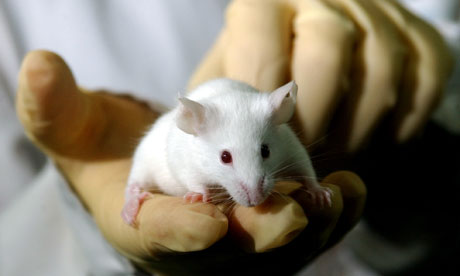
The light-sensitive rod cells partially restored the sight of mice born with night blindness.Scientists have improved the eyesight of mice born with night blindness by injecting healthy light-sensitive cells into their retinas.
 |
The light-sensitive rod cells partially restored the sight of mice born with night blindness.
Scientists have improved the eyesight of mice born with night blindness by injecting healthy light-sensitive cells into their retinas. The work is the first demonstration that cell transplants can restore useful vision.
Injections of the cells produced only modest changes in the animals' eyesight, but the results have raised hopes that a similar therapy might one day help reverse some forms of human blindness, such as age-related macular degeneration, the most common cause of blindness, which affects up to 15% of people over 75.
In the study, researchers at University College London's Institute of Ophthalmology injected the precursors of light-sensitive cells – taken from newborn mice – into the eyes of adult mice with a genetic form of night blindness.
Each jab delivered around 200,000 photoreceptor cells, of which 20,000 to 30,000 attached to the animals' retinas and made working neural connections. Despite the newly wired-up cells accounting for less than one percent of the rods in the retinas, the mice still showed an improvement in eyesight.
"This is the first proof of principle for restoring vision by transplanting photoreceptor cells. Until now it's been assumed, and hoped for, but not actually proven," said Dr Rachael Pearson, a neuroscientist at the institute, who led the study published in Nature.
The retina contains two broad kinds of light sensitive cells, rods and cones. In mice – and humans – more than 95% are rods. These work well in the dark and are good at spotting movement, but see the world in black and white. Cones are far less numerous, but give a sharp, colour view of the world in good lighting conditions.
The scientists used only rods in the latest experiments, as they are easier to transplant, but they are now pushing ahead with plans to repeat the work with cone cells. In humans, around 200,000 cones are concentrated in a small, central part of the retina called the fovea.
In a series of tests, including one that measured the animals' ability to distinguish varying shades of grey, and another that timed how quickly mice found a submerged platform in a water tank under low lighting conditions, the animals' vision was 10-20% as good as healthy mice. The animals that performed best had the most newly connected rod cells.
Untreated, the mice were effectively blind in dim light.
"Now we've discovered we can restore vision, it gives us impetus to go on and make the process better," said Prof Robin Ali, a senior author on the study.
Scientists need to clear several major hurdles before considering rod and cone transplants for human clinical trials. One crucial step is to make suitable donor cells, either from established stores of embryonic stem cells, or by converting patients' skin cells into photoreceptor cells. Another question is whether donor cells last for long when transplanted, or are rejected by the body's immune system.
"Although the work is done in animals and transplanted cells are isolated from newborn pups, the study is a proof of concept that photoreceptor transplantation is a feasible therapeutic strategy. Ideally, photoreceptors used for transplantation would be differentiated from pluripotent stem cells and it may take some time to do that successfully on a large scale," said Dusko Ilic, a stem cell scientist at Kings College London.
(Source: Guardian)





